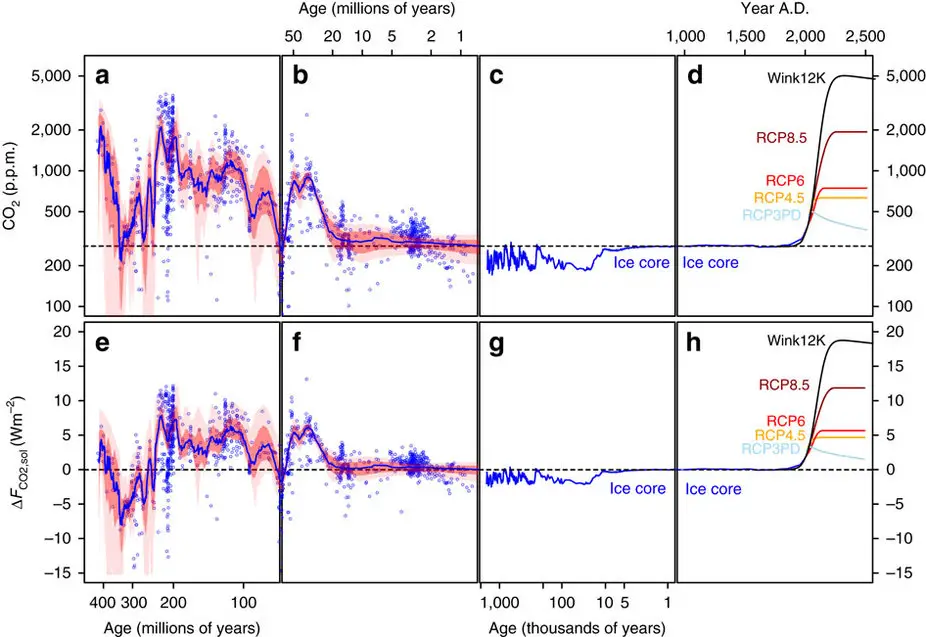
5th April 2017 Atmosphere could resemble Triassic by 22nd century If greenhouse gas emissions continue to rise, or if subsequent efforts to reverse climate change end in failure, the world's atmosphere could resemble that of the Triassic period by the 22nd century, according to a new study.
New research led by the University of Southampton suggests that, over the next 100 to 200 years, carbon dioxide concentrations in the Earth's atmosphere will head towards values not seen since the Triassic period, 200 million years ago. Furthermore, by the 23rd century, the climate could reach a warmth not seen in 420 million years. The study, published in Nature Communications, compiled over 1200 estimates of ancient atmospheric carbon dioxide (CO2) concentrations to produce a continuous record dating back nearly half a billion years. It concludes that if humanity burns all available fossil fuels in the future, the levels of CO2 contained in the atmosphere may have no geologically-preserved equivalent during this 420 million year period. The researchers examined published data on fossilised plants, the isotopic composition of carbon in soils and the oceans, and the boron isotopic composition of fossil shells. Gavin Foster, lead author and Professor of Isotope Geochemistry at the University of Southampton, explains: "We cannot directly measure CO2 concentrations from millions of years ago. Instead we rely on indirect 'proxies' in the rock record. In this study, we compiled all the available published data from several different types of proxy to produce a continuous record of ancient CO2 levels." This wealth of data shows that CO2 concentrations have naturally fluctuated on multi-million year timescales over this period, from around 200-400 parts per million (ppm) during cold 'icehouse' periods, to up to 3000 ppm during intervening warm 'greenhouse' periods. Although evidence tells us our climate has fluctuated greatly in the past (with the Earth currently in a colder period), it also shows the current speed of climate change is highly unusual.
Carbon dioxide is a potent greenhouse gas and during the last 150 years, humanity's fossil fuel extraction has increased its atmospheric concentration from 280 ppm in the pre-industrialisation era to nearly 405 ppm today. However, it is not just CO2 that determines the climate of our planet; ultimately it is both the strength of the greenhouse effect and the amount of incoming sunlight that is important. Changes in either parameter are able to force climate change. "Due to nuclear reactions in stars, like our Sun, over time they become brighter," adds co-author Dan Lunt, Professor of Climate Science at the University of Bristol. "This means that, although carbon dioxide concentrations were high hundreds of millions of years ago, the net warming effect of CO2 and sunlight was less. Our new CO2 compilation appears on average to have gradually declined over time by about 3-4 ppm per million years. This may not sound like much, but it is actually just about enough to cancel out the warming effect caused by the Sun brightening through time, so in the long-term it appears the net effect of both was pretty much constant on average." This interplay between carbon dioxide and the Sun's brightness has fascinating implications for the history of life on Earth. Co-author Professor Dana Royer, from Wesleyan University in the US, explains: "Up until now it's been a bit of a puzzle as to why, despite the Sun's output having increased slowly over time, scant evidence exists for any similar long-term warming of the climate. Our finding of little change in the net climate forcing offers an explanation for why Earth's climate has remained relatively stable, and within the bounds suitable for life for all this time." This long-term view also offers a valuable perspective on future climate change. It is well recognised that the climate today is changing at rates well above the geological norm. If humanity fails to tackle rising CO2 and burns all the readily available fossil fuel, then within the next two centuries, it will be at 2000 ppm – levels not seen since 200 million years ago. Professor Foster adds: "However, because the Sun was dimmer back then, the net climate forcing 200 million years ago was lower than we would experience in such a high CO2 future. So, not only will the resultant climate change be faster than anything the Earth has seen for millions of years, the climate that will exist is likely to have no natural counterpart, as far as we can tell, in at least the last 420 million years." ---
Comments »
|








